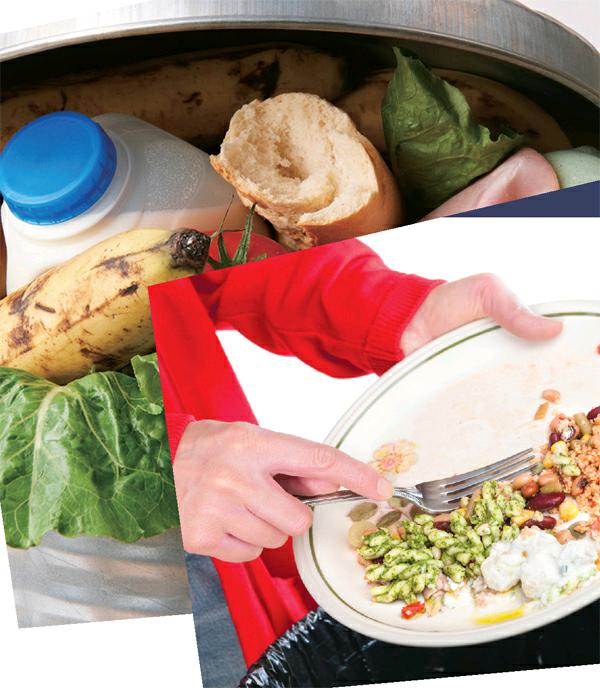Food Waste: A Growing Problem 舌尖上的浪费
2016-07-06ByClareKnutson&R
By+Clare+Knutson+&+Rachel+Sun
据统计,全球每年浪费的食物达到13万亿吨,占全球每年生产的食物总量的三分之一。我国每年在餐桌上浪费的食物价值约合2000亿元,相当于两亿多人一年的口粮,每年在餐桌外浪费的食物价值也高达750亿元。这些数字令人触目惊心,因此造成的资源浪费与环境破坏也令人痛惜。那造成食物浪费的原因是什么?食物浪费的严重后果有哪些?有无可行的解决方案?我们一起来了解。

When it comes to preserving food and reducing its waste, America is not the country paving the path, as $165 billion worth of food is being thrown out annually. The United States per capita food waste has increased almost 50 percent since 1974.
Multiple factors come into question when asking why Americans are so wasteful, ranging from produce not looking as aesthetically pleasing as the rest to ignorance on the accuracy of sell-by dates.
Not only is it wasteful to needlessly throw out food, it can also be costly to our environment and economy. According to the Natural Resources Defense Council, the process of getting food from the farms to our plates requires 10 percent of Americas total energy budget, makes up 80 percent of freshwater consumption in America and consumes 50 percent of Americas land. Yet, 40 percent of the food produced ends up in landfills.
It is predicted that by 2025, the world population will have increased from roughly 7 billion to around 8 billion. And while the population increase will be seen mostly in developing countries, it still poses an important question for all nations: “How will we feed all those people?”
Today, about one-sixth of the American population live in food-insecure households, meaning that families have to decide between buying food and other basic necessities. And yet, despite this deficit, the nation is still faced with the problem of overproduction of food, a large majority of which will be thrown out. There are families out there who are scrambling for food and yet there are families throwing whole bags of lettuce and fresh vegetables and fruits out.
However, its not just food that is being wasted when it is thrown out. The oil lost in the production of food that ends up in a landfill is 70 times greater than the amount lost in the Deepwater Horizon disaster of 20101).
It is estimated that reducing food waste by 15 percent would feed roughly 25 million Americans, while easing the environmental impacts. But to effectively reduce waste, it is necessary to improve preservation of the food and educate people and businesses on how to best avoid wastage.
Various factors come into question when discussing why food waste has augmented2) so much in the last few years. One of the many reasons is that consumers are attracted to aesthetically pleasing fruits and vegetables. When a fruit or vegetables appearance isnt held up to the normal standardized conditions, consumers often ostracize3) it because they believe there is something wrong with it.
“We have an industrialized food system where the fruits and vegetables that we grow have to be a certain shape and size in order to be whats considered marketable,” Farm Educator for the Abundant Table Erynn Smith says. “A lot of perfectly good fruits and vegetables unfortunately waste in the seals4) because they arent able to get a good enough price because theyre not the shape and size theyre supposed to be.”
The United States Department of Agriculture has a grading scale; if a fruit or vegetable doesnt match the criteria, it loses two-thirds of its market value to a farmer. If its not seen as profitable, farmers often discard it.
Smith believes that if consumers were to alter their demands of products, that would affect what farmers are growing.
“We live in a consumer culture where consumers drive the market,” she says. “Because we are accustomed to seeing huge apples or perfectly large sized lettuces, we dont want to choose anything that isnt deemed quote unquote5) perfect.
“Thats driving what farmers are able to grow and sell, so if we were able to change our consumer culture and educate ourselves as consumers that taste is not necessarily tied to size or shape, then we would be able to demand differently and that would affect what farmers are growing.”
Besides the beauty aspect of it, ignorance of sell-by dates is another factor contributing to the increase of food waste in landfills.
According to the Natural Resources Defense Council, nine out of ten consumers have at one point thrown out food that has passed its sell-by date, fearing its safety. However, as sell-by date labels arent regulated by the federal government, except for baby formulas, its accuracy is not as official as one might believe.
Sell-by dates are rarely ever exact and almost none reflect the safety of their content. Theyre merely suggestions from the manufacturers of when the product will be at its peak quality.
“There are actually dedicated websites that basically say that industries put the sell-by dates on products so that consumers will buy more, ” says health teacher Kurt Miller. “The sell-by dates are so short so as to increase the amount of products that consumers are buying. […] Now, of course there are a lot of foods that you certainly need to be more careful of like dairy and meats.”
Lastly, one of the biggest contributors to food waste is simply the fact that businesses and markets throw away leftover food when stores close rather than donating it to shelters for the homeless.
Due to the increase of food waste in landfills, a number of long-term consequences have appeared. One of the most dangerous ones is the release of methane6) gas.
Food lying beneath piles of waste is kept in an anaerobic7) state for lengthy periods of time and it decomposes without air. As a result, that airless setting releases methane, a greenhouse gas that traps heat.
Methane gas is dangerous in that if it is released into the atmosphere before being used, it absorbs the suns heat and warms the Earth. This can have a devastating impact on our climate as it is extremely effective in absorbing and trapping heat.
According to End Hunger, landfills are the greatest providers of human-related methane gas source. They account for nearly 34 percent of methane emissions.
Another consequence of food waste that future generations will encounter is a shortage of water and land resources. According to the Farmland Information Center, 40.8 percent of America is covered in farmland. The agricultural sector consumes approximately 70 percent of the worlds storage of freshwater, on a global scale.
“Were definitely going to see a depletion8) of resources for sure if people are going to keep throwing away food which hasnt gone bad or buying too much food,” Holmes says. “Its definitely going to be detrimental9) to future generations because if we dont watch what we throw away and how much were using our resources, then were really just being ignorant and not choosing to care about or respect our earth.”
The problem with food wastage is not one that can be corrected over the course of a few days, months or years. The U.S Department of Agriculture and Environmental Protection Agency announced that for the first time there will be a national target for reducing food waste.
In Seattle, citizens are fined for not sorting through their trash and recyclables. Massachusetts has begun to place food waste bans on schools and businesses. There is legislation that will increase tax deduction10) for businesses that donate surplus food.
The goal of the movement is not to force citizens to throw out less food, but to change the culture surrounding it. Such measures are aimed at educating the public and changing the mindset to one that is “sensitive” to food waste, while reaping the environmental and economic benefits at the same time.
Many stores are making the decision to sell produce that is perfectly fine in quality, but not quite as visually appealing. However, the rules regarding food safety are not as clear as they could be.
Holmes thinks that people will also need to learn the difference between sell-by dates (the suggested date for peak freshness) and expiration dates (the date passed which foods are no longer safe to eat).
“Learning the difference between an expiration date and a sell-by date is definitely important because some people will see the sell-by date and deem it unacceptable to eat after it has passed its sell-by date,” Holmes said.
Identifying which foods are wasted most often and why, in both businesses and at home, is key to keeping food from piling up in landfills.
“If you saw what a massive landfill looked like and if you saw all of the environmental and social impacts of landfills, you might be less likely to choose things that actually end up filling up our landfills. I think we all need to be responsible for recognizing and understanding the impacts of our choices,” Smith says.
说起保存食物和减少食物浪费,美国并未为此做好准备,因为在美国每年被扔掉的食物价值高达1650亿美元。自1974年以来,美国人均食物浪费量几乎增长了50%。
要问美国人为什么如此浪费,那有诸多因素值得思量,比如有些农产品外观不如其他的养眼,再比如消费者不知道最迟销售日期的准确度,等等。
不必要地扔食物不仅会造成浪费,而且还会使我们的环境和经济付出高昂的代价。据美国自然资源保护委员会称,食物从农场到餐盘的过程需要消耗的能源占美国能源总预算的10%,用水占美国淡水消耗量的80%,用地占美国土地资源的50%。然而,生产出来的食物中却有40%最终进了垃圾填埋场。
到2025年,世界人口预计将从约70亿增长到近80亿。尽管人口增长将主要发生在发展中国家,但还是向所有国家抛出了一个重要问题:“我们该如何养活所有这些人?”
目前,约有六分之一的美国人生活在食物无法得到保障的家庭中,这意味着这些家庭不得不在购买食物与购买其他生活必需品之间做出取舍。然而,即便存在这样食物不足的情况,美国却还面临着食物生产过剩的问题,而大多数过剩食物都会被扔掉。有家庭正在争着获取食物,而另外一些家庭却在扔掉整包的生菜、新鲜蔬菜和水果。
然而,扔掉食物浪费的不仅仅是食物本身。生产那些最终进了垃圾填埋场的食物所损耗的石油,比2010年墨西哥湾“深水地平线”钻井平台漏油事件所损失的石油要高出70倍。
据估算,食物浪费若减少15%,不仅可以减轻对环境的影响,还能养活约2500万美国人。但要真正有效地减少浪费,就必须提高食物保存技术,并让民众和商家了解如何最大限度地避免浪费。
要讨论食物浪费在过去几年为何增长如此迅猛,就要考虑多方面的因素。其中一个就是消费者钟情于品相好的水果和蔬菜。如果一个水果或一棵蔬菜的外观不符合通常的标准条件,消费者往往就会排斥它,因为他们认定它有问题。
“我们有一套工业化的食品体系。在这个体系中,我们种植的水果和蔬菜必须符合一定的形状和大小,以达到销售标准。”来自“丰富的餐桌”组织的农业教育者伊瑞恩·史密斯说,“很多非常好的水果和蔬菜都浪费在了密封袋里,只因它们的形状和大小不符合预期,无法卖到一个好价钱。这非常可惜。”
美国农业部有一个分级量表。如果一个水果或一棵蔬菜没有达到标准,对农民来说,它就失去了三分之二的市场价值。农民如果认为它不盈利,往往就会丢弃它。
史密斯认为,如果消费者能够改变自身对于农产品的要求,那么这将会对农民种什么产生影响。
“在我们所处的消费文化中,市场由消费者驱动,”她说,“由于我们习惯了看到大个儿的苹果和大棵的生菜,所以我们就不想选择任何不被视为‘完美的东西。
“而这推动着农民可以种什么和销售什么。因此,如果我们能够改变我们的消费文化,作为消费者能让自己明白,味道并非一定与大小和形状相关,那我们就会产生不同的需求,进而对农民种什么产生影响。”
除了品相方面的问题,导致垃圾填埋场里的食品废弃物增加的另一个原因是对最迟销售日期的无知。
据美国自然资源保护协会称,90%的消费者都曾因为担心安全问题而将超过最迟销售日期的食物扔掉。然而,除了婴儿配方奶粉,其他食品的最迟销售日期标签并不受联邦政府的规范管理,因此其精确度并不像人们所认为的那样具有权威性。
最迟销售日期极少是精确的,几乎没有一个能够反映食物的安全性。它们只是生产商对于产品处于最佳质量的时间说明而已。
“事实上,一些专业网站基本认为,企业在产品上标明最迟销售日期只是为了让消费者购买更多产品,”健康教师库尔特·米勒说,“最迟销售日期非常短,那是为了增加消费者购买产品的数量。[……]当然,现在有很多种食物你需要多加小心,比如乳制品和肉类。”
最后,导致食物浪费的最为重要的原因之一是,商家和市场在结束营业以后会把剩余的食物扔掉,而不是捐给收容所。
由于垃圾填埋场里的食品废弃物不断增多,很多有着长远影响的后果显现了出来,其中最危险的后果之一就是甲烷气体的释放。
堆积在层层垃圾下面的食物长期处在与氧气隔绝的状态,并在无空气的状态下进行分解。因此,这种不通气的环境会释放出甲烷——一种可以锁住热量的温室气体。
甲烷的危害在于,如果其在没使用之前就被释放到大气中,它会吸收太阳光的热量,让地球变暖。这会给我们的气候带来毁灭性的影响,因为甲烷能够十分有效地吸收和锁住热量。
据“终结饥饿”组织称,垃圾填埋场是人为排放甲烷的最主要来源,其排放量占到甲烷排放总量的近34%。
食物浪费使我们未来的子孙后代面临的另一个后果是水资源和土地资源的短缺。据农田信息中心称,美国40.8%的领土被农田覆盖。从全球范围来看,农业部门消耗的淡水约占世界淡水储量的70%。
“如果人们继续把那些还没变质的食物扔掉或者购买太多食物,我们以后肯定会遭遇资源枯竭,”霍尔姆斯说,“这对子孙后代而言有百害而无一利,因为如果我们继续无视我们扔掉的食物和我们消耗的资源数量,那我们就真是无知,没有选择关爱和尊重我们的地球。”
食物浪费带来的问题并非几天、几个月或几年就能纠正的。美国农业部和国家环境保护局宣布将会首次确立一个减少食物浪费的全国性目标。
在西雅图,市民如果不对垃圾和可回收利用物品进行分类将会被罚款。马萨诸塞州已经开始针对学校和商家颁布食物浪费禁令。还有立法规定将会给捐献剩余食物的商家增加免税额。
这项运动的目的不是强迫公民少扔食物,而是改变与之紧密相连的文化。这些举措旨在教育公众,使之转变观念,变得对食物浪费“敏感”,同时也收获环境和经济效益。
很多商店都决定销售那些品质优良但是品相不够吸引人的农产品。然而,关于食品安全的法规还未做到尽可能的明确。
霍尔姆斯认为,人们还需要学习最迟销售日期(产品新鲜程度处于最佳的建议日期)与保质期(超过该日期食用该产品有安全隐患)之间的区别。
“学习保质期与最迟销售日期之间的区别绝对重要,因为有些人会查看最迟销售日期,以为食物一旦过了最迟销售日期就不能食用了。”霍尔姆斯说。
防止食物在垃圾填埋场里堆积如山的关键是确定哪些食物是商家和家庭最常浪费的,并找到浪费的原因。
“如果你曾目睹巨大的垃圾填埋场是什么样子,如果你明白垃圾填埋场给环境和社会所带来的所有影响,你也许就不会去选购那些最终会被填埋在垃圾场里的东西了。我认为我们每个人都有责任认识和了解自己的选择会产生怎样的影响。”史密斯说。
1. Deepwater Horizon disaster of 2010:指的是2010年4月20日,英国石油公司在美国墨西哥湾租用的钻井平台“深水地平线”发生爆炸,导致大量石油泄漏,酿成一场经济和环境惨剧。
2. augment [??ɡ?ment] vt. 扩大,增加,增长
3. ostracize [??str?sa?z] vt. 排斥,摈弃
4. seal [si?l] n. 密封袋,密封装置
5. quote unquote:quote表示前引号,unquote表示后引号,两者合用相当于“所谓的”的意思。
6. methane [?mi?θe?n] n. [化]甲烷,沼气
7. anaerobic [??n??r??b?k] adj. 由无氧引起的,在缺氧的情况下生活(或发生)的
8. depletion [d??pli??(?)n] n. 耗尽,枯竭
9. detrimental [?detr??ment(?)l] adj. 有害的;不利的
10. deduction [d??d?k?(?)n] n. 扣除额,减除数
